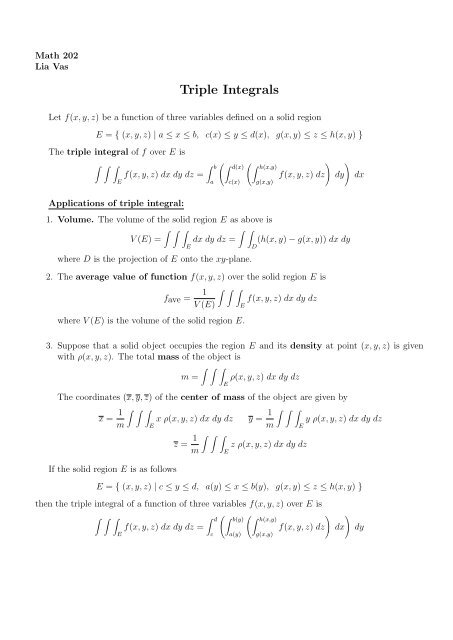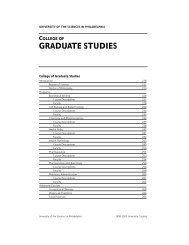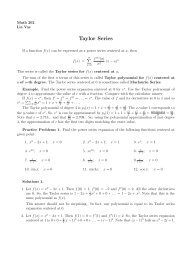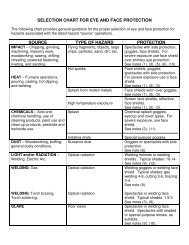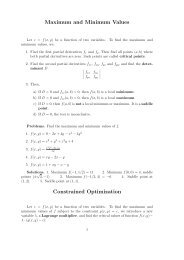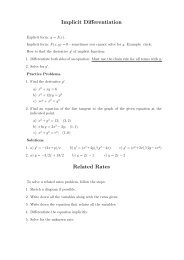Triple Integrals
Triple Integrals
Triple Integrals
Create successful ePaper yourself
Turn your PDF publications into a flip-book with our unique Google optimized e-Paper software.
Math 202<br />
Lia Vas<br />
<strong>Triple</strong> <strong>Integrals</strong><br />
Let f(x, y, z) be a function of three variables defined on a solid region<br />
E = { (x, y, z) | a ≤ x ≤ b, c(x) ≤ y ≤ d(x), g(x, y) ≤ z ≤ h(x, y) }<br />
The triple integral of f over E is<br />
∫ ∫ ∫<br />
∫ ( b ∫ ( d(x) ∫ h(x,y)<br />
)<br />
f(x, y, z) dx dy dz =<br />
f(x, y, z) dz<br />
E<br />
a c(x) g(x,y)<br />
dy<br />
)<br />
dx<br />
Applications of triple integral:<br />
1. Volume. The volume of the solid region E as above is<br />
∫ ∫ ∫<br />
∫ ∫<br />
V (E) = dx dy dz = (h(x, y) − g(x, y)) dx dy<br />
where D is the projection of E onto the xy-plane.<br />
2. The average value of function f(x, y, z) over the solid region E is<br />
fave = 1 ∫ ∫ ∫<br />
f(x, y, z) dx dy dz<br />
V (E) E<br />
where V (E) is the volume of the solid region E.<br />
E<br />
3. Suppose that a solid object occupies the region E and its density at point (x, y, z) is given<br />
with ρ(x, y, z). The total mass of the object is<br />
∫ ∫ ∫<br />
m = ρ(x, y, z) dx dy dz<br />
The coordinates (x, y, z) of the center of mass of the object are given by<br />
x = 1 ∫ ∫ ∫<br />
x ρ(x, y, z) dx dy dz y = 1 ∫ ∫ ∫<br />
y ρ(x, y, z) dx dy dz<br />
m E m E<br />
z = 1 ∫ ∫ ∫<br />
z ρ(x, y, z) dx dy dz<br />
m E<br />
If the solid region E is as follows<br />
E<br />
E = { (x, y, z) | c ≤ y ≤ d, a(y) ≤ x ≤ b(y), g(x, y) ≤ z ≤ h(x, y) }<br />
D<br />
then the triple integral of a function of three variables f(x, y, z) over E is<br />
∫ ∫ ∫<br />
∫ ( d ∫ ( b(y) ∫ )<br />
h(x,y)<br />
f(x, y, z) dx dy dz =<br />
f(x, y, z) dz<br />
E<br />
c<br />
a(y)<br />
g(x,y)<br />
dx<br />
)<br />
dy
Practice problems.<br />
1. Evaluate the triple integral<br />
a) ∫ ∫ ∫<br />
E<br />
x 3 y 2 z dx dy dz<br />
where E = { (x, y, z) | 1 ≤ x ≤ 2, 0 ≤ y ≤ x, 0 ≤ z ≤ y 2 }<br />
b) ∫ ∫ ∫<br />
E<br />
2x dx dy dz<br />
where E = { (x, y, z) | 0 ≤ y ≤ 2, 0 ≤ x ≤ √ 4 − y 2 , 0 ≤ z ≤ y }<br />
c) ∫ ∫ ∫<br />
E<br />
6xy dx dy dz<br />
where E lies under the plane z = x + y + 1 and above the region in the xy-plane bounded<br />
by the curves y = √ x, y = 0 and x = 1.<br />
d) ∫ ∫ ∫<br />
E<br />
xy dx dy dz<br />
where E is the solid tetrahedron with vertices (0,0,0), (1, 0, 0), (0, 2, 0) and (0, 0, 3).<br />
2. Find the volume of the tetrahedron bounded by the coordinate planes and the plane 2x + 3y +<br />
6z = 12.<br />
3. Find the average value of the function f(x, y, z) = xyz over the cube with side length 4 that<br />
lies in the first octant with one vertex in the origin and edges parallel to the coordinate axes.<br />
4. Find the mass and the center of mass of the solid E given in problem 1c) and that has the<br />
density function ρ(x, y, z) = 2.<br />
Solutions.<br />
1. a) ∫ 2<br />
∫ x<br />
1 0<br />
∫ y 2<br />
0 x 3 y 2 z dx dy dz = ∫ 2<br />
1 x3 dx ∫ x<br />
0 y2 dy ∫ y 2<br />
0 z dz = ∫ 2<br />
1 x3 dx ∫ x<br />
0 y2 dy z2<br />
2 |y2 0 = ∫ 2<br />
1 x3 dx ∫ x<br />
0<br />
y 6<br />
2 dy = ∫ 2<br />
1 x3 dx y7<br />
14 |x 0 = ∫ 2<br />
1 x10<br />
14<br />
dx =<br />
x11<br />
14(11) |2 1 = 13.29.<br />
b) Here you have to evaluate the integral with respect to y last since all the other variables<br />
have y in the bounds. ∫ 2<br />
0 dy ∫ √ 4−y 2<br />
0 2x dx ∫ y<br />
0 dz = ∫ 2<br />
0 dy ∫ √ 4−y 2<br />
0 2x dx y = ∫ √<br />
2<br />
0 y dy x2 4−y<br />
|<br />
2<br />
0 =<br />
∫ 2<br />
0 y(4 − y2 ) dy = (2y 2 − y4<br />
4 )|2 0 = 8 − 4 = 4.<br />
c) Sketch the region in xy-plane first. The x-bounds are 0 ≤ x ≤ 1. The y-bounds are<br />
0 ≤ y ≤ √ x. The z-bounds are determined by the plane z = x + y + 1 and the xy-plane<br />
and so 0 ≤ z ≤ x + y + 1. So ∫ 1 ∫ √ x ∫ x+y+1<br />
0 0 0 6xy dx dy dz = ∫ 1<br />
0 6xdx ∫ √ x<br />
0 y dy ∫ x+y+1<br />
0 dz =<br />
∫ 1<br />
0 6xdx ∫ √ x<br />
0 y dy(x + y + 1) = ∫ 1<br />
y2<br />
0 6xdx (x + y3<br />
+ y2<br />
2 3 2 )|√ x<br />
0 = ∫ 1<br />
0 6xdx (x x + x3/2 + x) = 65.<br />
2 3 2 28
d) First, find the equation of the plane determined by P = (1, 0, 0), Q = (0, 2, 0) and R =<br />
(0, 0, 3). Vectors −→ P Q = (−1, 2, 0) and −→ P R = (−1, 0, 3) are in the plane so the vector perpendicular<br />
to the plane can be taken to be the cross product −→ P Q× −→<br />
⃗i ⃗j ⃗ k<br />
P R =<br />
−1 2 0<br />
= (6, 3, 2). The<br />
∣ −1 0 3 ∣<br />
equation of plane, using point P for example, is 6(x − 1) + 3y + 2z = 0 ⇒ 6x + 3y + 2z = 6 ⇒<br />
z = 3 − 3x − 3y.<br />
2<br />
Thus, the upper bound for z is 3 − 3x − 3 y. The lower bound for z is 0. In xy-plane we have<br />
2<br />
a triangle with vertices (0,0), (1,0) and (0,2). So, the bounds for x are 0 ≤ x ≤ 1. The lower<br />
bound for y is 0 and the upper bound is the line passing (0,2) and (1,0). The equation of this<br />
line is y = −2x + 2. Thus,<br />
∫ ∫ ∫ ∫ xy dx dy dz = 1<br />
0 xdx ∫ −2x+2<br />
0 ydy ∫ 3−3x− 3 2 y<br />
0 dz = ∫ 1<br />
0 xdx ∫ −2x+2<br />
0 ydy (3 − 3x − 3y) = 2<br />
∫ 1<br />
0<br />
xdx (3<br />
y2<br />
= 1<br />
10 .<br />
2<br />
− 3x<br />
y2<br />
2 − y3<br />
2 )|−2x+2<br />
0 = ∫ 1<br />
0<br />
xdx (3<br />
(−2x+2)2<br />
2<br />
− 3x (−2x+2)2<br />
2<br />
− (−2x+2)3<br />
2<br />
) = use calculator<br />
2. The upper bound for z can be obtained by solving 2x + 3y + 6z = 12 for z. So, 0 ≤ z ≤<br />
2 − 1x − 1 y. The projection of the relevant region in xy-plane is a triangle determined by the<br />
3 2<br />
coordinate axes and by the line 2x + 3y + 6(0) = 12 ⇒ y = 4 − 2 x (alternatively, find the<br />
3<br />
equation of the line passing (6,0) and (0,4)). The bounds for x are 0 ≤ x ≤ 6. The volume is<br />
V = ∫ 6<br />
0 dx ∫ 4− 2 3 x<br />
0 dy ∫ 2− 1 3 x− 1 2 y<br />
0 dz = ∫ 6<br />
0 dx ∫ 4− 2 3 x<br />
0 dy (2− 1x− 1y) = ∫ 6<br />
3 2 0 dx (2y − 1 y2<br />
xy − 2 3 4 )|4− 3 x<br />
0 =<br />
∫ 6<br />
0 dx (2(4 − 2x) − 1x(4 − 2x) − (4− 2 3 x)2<br />
) = use calculator = 8.<br />
3 3 3 4<br />
3. When integrating over the cube, the bounds for all three variables are 0 and 4. The volume of<br />
the cube of side 4 is 4 3 = 64 (which agrees with the fact that V = ∫ 4 ∫ 4 ∫ 4<br />
0 0 0 dxdydz = x|4 0y| 4 0z| 4 0 =<br />
64).<br />
The average value is f ave = 1<br />
64<br />
∫ 4 ∫ 4 ∫ 4<br />
0 0 0<br />
1 x<br />
xyz dxdydz = 2<br />
64 2 |4 y 2<br />
0 2 |4 0 z2<br />
2 |4 0 = 1<br />
64 83 = 8.<br />
4. The bounds are the same as in problem 1c. The mass is m = ∫ 1<br />
0<br />
∫ 1<br />
0 2 dx ∫ √ x<br />
0 (x + y + 1)dy = ∫ 1<br />
∫ √ x ∫ x+y+1<br />
0 0 2 dx dy dz =<br />
0 2(x√ x + x + √ x) dx = 2.633.<br />
2<br />
The x-coordinate is x = 1 ∫ √<br />
2.633 int1 x ∫ x+y+1<br />
0 0 0 2xdx dy dz = 1<br />
2.633 int1 02x(x √ x + x + √ x) dx =<br />
2<br />
= 0.647. Similarly you find that y = 0.418, and z = 1.032.<br />
1.705<br />
2.633


